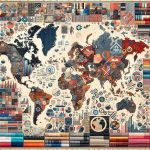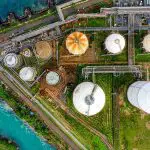You might not realize that the fabric industry is one of the oldest and most influential sectors affecting global economics. It shapes countless industries, from fashion to automotive, and drives significant employment in countries like China, India, and Bangladesh. As consumer preferences shift and sustainability becomes a pressing concern, the fabric industry's adaptation through innovation and strategic responses is essential. Understanding its impact on trade dynamics and how government policies play a role in its evolution could change your perspective on this often overlooked economic powerhouse.
Table of Contents
Key Takeaways
- Fabric production hubs like China and India shape global economies with skilled labor and advanced technologies.
- The fabric industry provides significant employment, fostering economic growth and gender diversity in the workforce.
- Trade and exports in fabric drive economic growth and open global market opportunities through strategic trade agreements.
- Technological innovations in fabric production enhance efficiency and quality, setting benchmarks with advancements like 3D knitting and smart textiles.
- Sustainable practices in fabric production minimize environmental impact and build consumer trust through eco-friendly methods and certifications.
Historical Significance
Fabric's historical significance can't be overstated, as it has played an essential role in shaping economies throughout the ages. When you look at the impact on fashion, you'll see that fabric isn't just a material; it's a cultural cornerstone. From the silk trade routes of ancient China to the opulent tapestries of European courts, fabric has influenced societal norms, class distinctions, and even political power. It's not merely about clothing; it's about identity and status.
Consider the cultural significance woven into every thread. In ancient Egypt, linen was so prized that it was used as currency and in mummification, signifying purity. Meanwhile, in India, the intricate designs of traditional sarees reflect regional diversity and storytelling, making each piece a cultural artifact. The impact on fashion is undeniable; fabric dictates trends, sets standards, and even incites revolutions. For instance, the Industrial Revolution was spurred by advancements in textile manufacturing, transforming economies and social structures.
Understanding fabric's historical significance gives you a profound respect for its economic role. You see how deeply intertwined fabric is with human progress, shaping and reflecting the values and advancements of civilizations through time.
Global Production Hubs
As you appreciate fabric's historical significance, it's fascinating to explore today's global production hubs that continue to drive the textile industry's economic impact.
Countries like China, India, and Bangladesh are at the forefront, leveraging their vast resources, skilled labor, and advanced technologies to dominate global fabric production. These hubs aren't just manufacturing centers; they're critical nodes in the intricate web of global sourcing that guarantees fabric reaches every corner of the world.
Understanding market dynamics is essential when looking at these production hubs. For instance, China's dominance in synthetic fabrics is unparalleled, while India's expertise lies in cotton and handwoven textiles. Bangladesh has carved a niche in ready-made garments, often producing for international brands.
Each of these hubs adapts to shifts in consumer demand, trade policies, and technological advancements, ensuring they remain competitive and integral to the global textile supply chain.
Employment Impact
The textile industry plays a pivotal role in providing employment opportunities across various global production hubs. You'll find that it's not just a matter of making clothes; it's about job creation and spurring economic growth. In countries like Bangladesh, Vietnam, and India, the textile sector employs millions, lifting families out of poverty and driving local economies forward.
When you explore into the labor market, you'll notice the dynamic nature of the textile workforce. It's a sector that employs a wide array of skills, from unskilled laborers to highly specialized technicians. This diverse employment landscape doesn't just offer jobs; it creates a pathway for skill development and upward mobility. For many, working in textiles is the first step towards more advanced roles within the industry.
Moreover, the textile industry's impact on workforce dynamics is profound. It often leads to increased gender diversity, as a significant portion of the workforce is female. This inclusivity boosts household incomes and fosters greater community economic stability.
Trade and Exports
Trade and exports constitute the lifeblood of the textile industry, driving both economic growth and international collaboration. You'll find that export growth is a clear indicator of a nation's economic health and its textile sector's competitiveness. Countries skilled at producing high-quality fabrics often secure profitable trade agreements that open doors to global markets, enhancing their economic standing.
You should pay attention to how trade agreements shape the landscape. These agreements lower tariffs, reduce trade barriers, and create opportunities for textile firms to expand their reach. By skillfully maneuvering through these agreements, countries can boost their export growth and gain a stronger foothold in the global market.
Moreover, the interplay of supply and demand in different regions affects pricing, production schedules, and even fashion trends. You can see how adept management of trade and exports enables nations to respond swiftly to global market changes, ensuring a steady flow of goods and capital.
Understanding these dynamics is vital for anyone aiming to master the economic role of textiles. By focusing on export growth and leveraging trade agreements, you can appreciate how countries build robust, resilient textile industries that thrive in the ever-changing global economy.
Technological Innovations
Harnessing cutting-edge technology, the textile industry is revolutionizing everything from production processes to fabric functionalities. You're seeing automation advancements reshape how textiles are manufactured, increasing efficiency and reducing labor costs. This leap in automation not only accelerates production but also elevates quality control, ensuring that fabrics meet exacting standards. As a result, market competition intensifies, pushing companies to adopt these technologies or risk being left behind.
You're also witnessing a digital transformation that's causing industry disruption across the board. Advanced software and data analytics enable real-time monitoring and predictive maintenance, drastically reducing downtime. The integration of IoT (Internet of Things) devices into textile machinery allows for seamless communication between equipment, optimizing performance and minimizing waste. This digital shift isn't just limited to the production floor; it extends to supply chain management, inventory control, and even e-commerce platforms, enhancing overall operational efficiency.
Moreover, innovations like 3D knitting and smart textiles are opening new horizons. Imagine fabrics that can monitor your health or adjust their properties based on environmental conditions. These advancements aren't just novelties; they're setting new benchmarks, ensuring the textile industry remains at the forefront of technological prowess.
Sustainable Practices
Embracing sustainable methods, the textile industry is making significant progress in reducing its environmental impact. By adopting a circular economy model, you make sure that materials are reused and recycled, minimizing waste. This approach not only conserves resources but also reduces the carbon footprint of textile production.
Ethical sourcing plays a pivotal role here; by prioritizing suppliers who adhere to fair labor practices and environmentally-friendly methods, you contribute to a more sustainable supply chain.
To master the art of sustainability in textiles, focus on integrating renewable materials and innovative recycling techniques. For instance, using organic cotton or recycled polyester can significantly reduce water usage and pollution. You should also invest in technologies that enhance the durability of fabrics, extending their lifecycle and reducing the need for frequent replacements.
Consider partnering with organizations that specialize in sustainability certifications, as these can add credibility to your efforts. By transparently communicating your sustainable practices, you build trust with consumers who are increasingly demanding eco-friendly products.
Essentially, your commitment to sustainable practices not only benefits the planet but also positions your business as a leader in the ever-evolving textile industry.
Economic Challenges
You can't overlook the economic challenges facing the fabric industry.
Rising production costs, the impact of trade tariffs, and supply chain disruptions are significant hurdles.
Understanding these issues is important for successfully maneuvering the market.
Rising Production Costs
Increasing production expenses pose significant economic challenges for the fabric industry. When you consider cost fluctuations, it's evident that market competition intensifies. Raw material prices often vary, impacting your ability to maintain stable pricing. This volatility means that staying competitive requires careful planning and flexible decision-making. You can't afford to overlook these fluctuations if you aim to keep your market edge.
Supply chain complexities further exacerbate the issue. A disrupted supply chain can lead to delays and increased costs, eroding your profit margins. Efficient logistics and reliable supplier relationships become vital. You need to guarantee that every link in your supply chain operates seamlessly to mitigate unexpected expenses.
Profit margins are already thin in this competitive market. Rising labor costs, energy expenses, and environmental regulations add pressure. To preserve profitability, you must innovate continuously. Whether it's adopting cost-effective technologies or optimizing processes, finding ways to cut costs without sacrificing quality is essential.
Ultimately, managing these challenges demands a proactive approach. You must stay informed, adapt quickly, and leverage every opportunity to minimize costs. Balancing these factors effectively can help you thrive despite the financial pressures bearing down on the fabric industry.
Trade Tariffs Impact
On top of escalating production costs, trade duties add another layer of economic strain that can greatly alter the fabric sector's terrain. You'll observe that duties can cause significant market fluctuations, making it challenging for businesses to predict costs and profits accurately. This unpredictability can impede industry competitiveness as companies struggle to maintain profit margins while staying competitive in price.
Trade duties can disrupt the delicate balance of economic stability within the fabric sector. When duties are imposed, they often lead to increased costs for raw materials and finished goods. This trickle-down effect can push prices up, making it more challenging for you to maintain the same level of profitability without passing those costs onto consumers. Consequently, higher prices can reduce demand, further stressing the industry.
Moreover, trade agreements play a pivotal role in mitigating these impacts. Without favorable trade agreements, the industry faces greater exposure to duties and other trade barriers. These agreements can help stabilize the market, providing a buffer against sudden economic shocks.
Therefore, understanding and navigating the complexities of trade duties and agreements is essential for anyone looking to master the fabric industry's economic landscape.
Supply Chain Disruptions
Supply chain disruptions can wreak havoc on the fabric industry's economic stability. When shipping delays, raw material shortages, and logistical bottlenecks occur, they create a ripple effect that impacts every stakeholder in the supply chain.
You must understand that even a slight delay in receiving raw materials can halt production lines and lead to unmet customer demand. This instability can exacerbate market volatility, making it challenging for businesses to forecast and plan effectively.
Moreover, the global nature of the fabric industry means that disruptions in one region can have far-reaching consequences. For instance, if a key supplier in Asia experiences a logistical bottleneck, manufacturers in Europe and North America may face significant delays and increased costs. These disruptions can also affect inventory levels, leading to either overstock or stockouts, both of which are detrimental to economic health.
To navigate these challenges, you need to develop robust contingency plans and diversify your supply chain. By doing so, you can mitigate risks and maintain a level of operational resilience.
Staying agile and adaptive in the face of market volatility will guarantee you remain competitive and economically viable.
Consumer Demand
Consumer demand drives the fabric industry by influencing production decisions and market trends. Your preferences shape the types of fabrics that manufacturers prioritize. As you lean towards sustainable materials, for instance, producers adapt, shifting focus to eco-friendly options. This dynamic directly impacts market trends, steering the industry toward innovative, sustainable solutions.
However, supply chain disruptions can hinder this responsiveness. When events like natural disasters or geopolitical tensions occur, they can break the supply chain, creating scarcity and driving up costs. You'll notice these effects in the form of higher prices or limited availability of certain fabrics. This interplay between consumer demand and supply chain stability is essential in understanding the fabric market's resilience.
Global competition also plays a significant role. As a consumer, your access to a diverse range of fabrics from different countries intensifies competitive pressures. Producers around the globe vie for your attention, pushing them to innovate and improve quality. This global competition guarantees that your preferences continually drive the evolution of the market, making it more dynamic and interconnected.
Understanding these factors empowers you to make informed choices, recognizing how your demand shapes the global fabric industry.
Government Policies
You need to understand how government policies shape the fabric industry.
Trade tariffs can affect prices, while subsidies and incentives might encourage local production.
Import-export regulations also play a pivotal role in determining market dynamics.
Trade Tariffs Impact
Often, trade tariffs greatly influence the fabric industry's economic landscape by altering production costs and market dynamics. When tariffs are imposed, they can lead to significant market fluctuations. You'll see prices rise, and this can impact both producers and consumers. However, the industry's resilience often shines through as businesses adapt to these changing conditions. Companies may shift their supply chains, seek new markets, or innovate to maintain their competitive edge.
Global competition becomes even fiercer under these circumstances. As tariffs vary from country to country, some nations may gain an advantage while others struggle to keep up. Navigating these intricacies requires astute trade negotiations. Governments and industry leaders must work together to strike deals that minimize adverse impacts while maximizing opportunities.
For those involved in the fabric trade, understanding the nuances of trade tariffs is essential. It's not just about knowing the current rates but also about anticipating changes and preparing for them. Successful navigation of this challenging landscape often hinges on staying informed and being agile. By mastering these aspects, you'll be better equipped to thrive in a world where trade policies are constantly evolving.
Subsidies and Incentives
Governments often provide subsidies and incentives to strengthen the fabric industry, aiming to enhance economic growth and global competitiveness. By offering financial support, they help reduce production costs, enabling fabric manufacturers to innovate and expand their operations. This government support is pivotal for driving industry growth and ensuring that domestic players can compete on a global scale.
Here's a snapshot of how different countries implement these strategies:
| Country | Type of Support | Impact on Industry Growth |
|---|---|---|
| USA | Tax Credits | Increased R&D and technological advancements |
| China | Direct Subsidies | Reduced production costs |
| India | Export Incentives | Enhanced global market presence |
| Germany | Grants and Loans | Facilitated modernization of facilities |
| Bangladesh | Duty Drawbacks | Lowered operational expenses |
You can see that each nation's approach varies, but the goal remains the same: to promote a thriving fabric sector. By understanding these policies, you can better appreciate the strategic moves that shape the industry. Leveraging government support can significantly influence your business's ability to innovate, grow, and compete on the global stage. Stay informed and adapt to these policies to harness their full potential for your enterprise.
Import-Export Regulations
Finding your way through the intricate network of import-export regulations is necessary for fabric manufacturers seeking to broaden their market reach. Navigating customs clearance is a crucial step in ensuring your fabric products move smoothly across borders. You'll need to prepare accurate documentation, including invoices, packing lists, and certificates of origin. Each country has specific requirements, so meticulous attention to detail will save you from costly delays or penalties.
Trade agreements play a pivotal role in shaping the landscape of import-export regulations. By leveraging these agreements, you can benefit from reduced tariffs and streamlined customs procedures. Familiarize yourself with the major trade agreements relevant to your target markets, such as NAFTA or the EU's preferential trade arrangements. These agreements can significantly impact your cost structure and competitive positioning.
It's also essential to stay updated on any changes in government policies that might affect your operations. Regulatory landscapes are dynamic, and staying informed will help you adapt quickly. Consider employing specialized software or consulting with trade experts to stay on top of compliance requirements.
Mastering these aspects of import-export regulations will equip you with the knowledge and agility to thrive in the global fabric market.
Future Trends
Looking ahead, you'll notice that innovations in sustainable textiles are set to revolutionize the fabric industry. Market predictions show that eco-friendly materials could dominate, leading to significant industry disruptions. You'll see a shift in consumer behavior as people now demand more transparency and sustainability in their purchases. Companies that don't adapt may struggle to compete in this evolving landscape.
Technological advancements in textile manufacturing are also transforming the market. Smart fabrics with embedded sensors, self-cleaning capabilities, and enhanced durability are no longer science fiction but imminent realities. As these technologies become more mainstream, consumer expectations will evolve, pushing for greater functionality and performance in everyday wear.
Here's a quick snapshot of key future trends:
| Trend | Impact | Timeline |
|---|---|---|
| Sustainable Materials | Market Leadership | 2023-2025 |
| Smart Fabrics | Consumer Demand Shift | 2024-2026 |
| Eco-friendly Processes | Industry Standardization | 2023-2027 |
| Circular Economy | Waste Reduction | 2024-2028 |
| Digital Integration | Enhanced Consumer Experience | 2023-2026 |
Frequently Asked Questions
How Does Fabric Pricing Vary Across Different Regions?
You'll notice fabric pricing varies by region due to regional pricing and market trends. The economic impact of fabric trade influences these differences, as local economies and demand dictate costs uniquely in each area.
What Are the Primary Types of Fabrics in Demand Globally?
You're curious about the primary types of fabrics in demand globally. Sustainable textiles and fabric technology lead the market, driven by fashion trends and textile innovations. Mastery in these areas guarantees you stay ahead in the industry.
How Do Cultural Preferences Influence Fabric Consumption?
Cultural preferences weave a tapestry of influence on fabric consumption. You see fashion trends and consumer behavior shaped by the textile industry's understanding of cultural significance, tailoring products to suit diverse tastes and traditions.
What Role Do Fabric Markets Play in Local Economies?
You'll find fabric markets essential in local economies. They drive economic impact through vibrant market dynamics, shaping pricing strategies that benefit local communities. Mastering these elements enhances your understanding of their integral role in economic development.
How Does Climate Affect Fabric Production and Quality?
Hot climates boost cotton growth, while cold ones hinder silk production. You face production challenges like droughts or frost impacting quality. Climate impact dictates fabric types, so mastering adaptability is essential for maintaining premium standards.
- Will 100% Cotton Percale Wrinkle? The Honest Truth - July 15, 2025
- Why Do Toenails Tear Percale Sheets and How to Prevent It - July 15, 2025
- Why Is Percale Considered a Superior Sheet? - July 15, 2025







